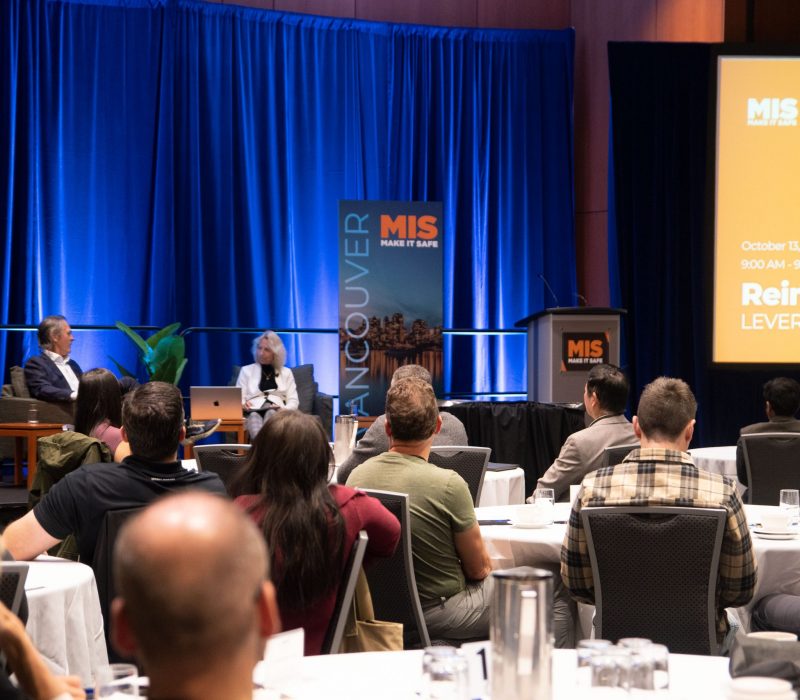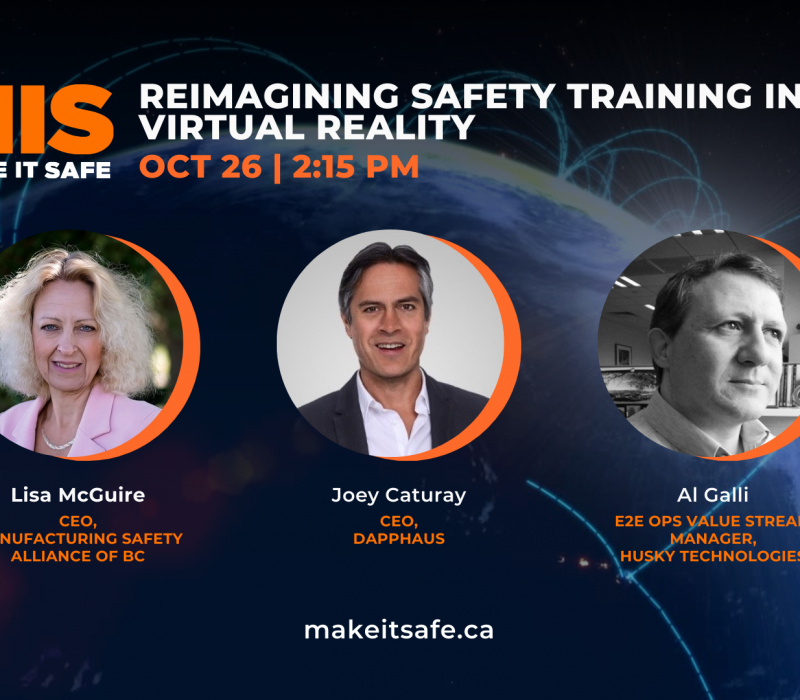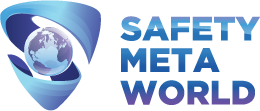
Immersive training through virtual or augmented reality (VR/AR) has been demonstrated to reduce training time by more than 40 percent and to improve retention and learning effectiveness by as much as 75 percent. Employees enjoy the experience, learn faster—and free from physical hazards—and remember what they have learned.
Unsurprisingly, more employers are seeking out immersive training solutions for their teams.
The opening keynote presentation on the subject at Make It Safe 2023 in Vancouver (recorded and replayed at Make It Safe Online and On Demand) highlighted the benefits of immersive training through an in-depth look into the experience of global injection molding leader Husky Technologies.
In a collaboration with Dapphaus, Husky employed extended reality training tools to standardize and scale world-class training for their service technicians around the world.
Safety Meta World CEO Lisa McGuire interviewed Joey Caturay, CEO of Safety Meta World developer Dapphaus, and Husky Technologies E2E Ops Value Stream Manager Al Galli. Through Husky’s experience, this unique keynote provided a sneak peek for attendees into the technology they would soon be able to access with the launch of Safety Meta World.
Husky rolled out their immersive training solution for lockout/tagout assessments, which they call Extended Reality Lockout/Tagout, to their technicians around the world.
“With a global footprint and technicians in developed and developing countries, the challenge is to get those people into one common learning environment at any given time.”
Virtual meetings, Galli notes, couldn’t provide the interactivity they needed to assess technicians’ ability to execute safety requirements and guidelines. “The challenge really is getting to everybody,” he adds, “sharing the knowledge, and assessing whether the knowledge has been effectively delivered.”


In the past, this type of training and certifications required Husky
to fly technicians out to training campuses—a much slower and costly
process compared to how they are able to do it today.
In this video clip, Galli describes the rationale and benefits for Husky of this type of immersive training program:
“We created an immersive, interactive environment for the technician to not just tell us what they need to do, but to actually show us,” Galli says.
“We can assure ourselves that our technicians not only understand the theory but can actively apply the theory in practice.”
With the immersive training and authorization program, Galli notes, “We’re able to say unequivocally that they know and understand how to properly lock out and tag out our systems and give them authorization.”
The success so far, he notes, has been beyond expectations.
“It has been accepted universally by young and old technicians as ‘this is the future of training.’ They felt like they were with the trainer, in the training in the environment…mimicking real world. It taught them things that a simple meeting or theoretical session would not have done.”
The training team was on board from the first, Galli notes, seeing immersive training in “extended reality” as the path to getting things done in a more effective and efficient way.
The benefits at Husky have been significant—in cost savings over traditional training methods and travel; increased speed of training and certification, standardization of best practice in training content and delivery, increased employee engagement, scale of training and assessment, and improved health and safety performance.
Husky has traditionally required a three-year refresh on Lockout/Tagout certification, Galli says. Today, the success of the Extended Reality training program has led Husky to reevaluate: “Why wait three years?” Given the ease and efficiency of this form of training, the company is now looking at annual training refreshes and self-guided certifications as ways to increase safety.
“It’s very simple game elements that make this form of training engaging.”
With the immersive training and authorization program, Galli notes, “We’re able to say unequivocally that they know and understand how to properly lock out and tag out our systems and give them authorization.”
The success so far, he notes, has been beyond expectations.
“It has been accepted universally by young and old technicians as ‘this is the future of training.’ They felt like they were with the trainer, in the training in the environment…mimicking real world. It taught them things that a simple meeting or theoretical session would not have done.”
The training team was on board from the first, Galli notes, seeing immersive training in “extended reality” as the path to getting things done in a more effective and efficient way.
The benefits at Husky have been significant—in cost savings over traditional training methods and travel; increased speed of training and certification, standardization of best practice in training content and delivery, increased employee engagement, scale of training and assessment, and improved health and safety performance.
Husky has traditionally required a three-year refresh on Lockout/Tagout certification, Galli says. Today, the success of the Extended Reality training program has led Husky to reevaluate: “Why wait three years?” Given the ease and efficiency of this form of training, the company is now looking at annual training refreshes and self-guided certifications as ways to increase safety.
Why does it work? Caturay notes that elements in games like progress bars, levels, in-game awards or currencies give players—or trainees—instant feedback. By way of example, he mentioned the pilot session for the Husky training with 20 resident technicians. “When lunchtime came around nobody left,” he said. “They wanted to keep ‘playing’ the training simulation.”
In addition, he notes, because everything that happens within a simulation is tracked and recorded, it is easy to identify issues and make sure the training is effective.
Asked about the benefits of immersive training, Caturay points to a “landmark” study by Jeremy Dalton, who leads the Metaverse Technologies team for PwC United States.
“The numbers in that study related to this type of training are astonishing,” Caturay says, “but there’s one that’s emblazoned on my mind: 3.75X the emotional connectedness to the training material.”
Workplace training typically does not have a reputation for emotional connection and engagement. Gamification and immersive and experiential training environments such as Safety Meta World are positioned to turn that around.
Caturay says the typical feedback from people all levels of the companies that use their training products is, “Why didn’t we do this sooner?”

Training workers on real
situations in real time-
without the risks of the real world.